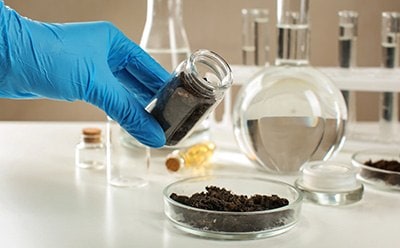Soil, Solid Waste & Groundwater Testing

Soil and groundwater testing are crucial to monitor industrial discharges that may adversely affect the environment and human health. There are numerous technical articles, protocols, and approved analytical methods available to guide solid waste management and testing for heavy metals and other environmental pollutants.
Related Technical Articles
- The analysis of low concentrations of PO4-P in natural, uncontaminated waters is often challenging. The Spectroquant® photometric test provides an easy-to-use and sensitive method for quantification with results comparable to DIN EN ISO 6878.
- Neonicotinoids have established themselves as key components in insecticides because of their unique selectivity. The mode of action is similar to nicotine.
- This page shows the performance of Whatman™ Grade 40 and Grade 41 quantitative ashless filter paper in three metal content tests, high molybdenum, lead, and zinc for the mining industry.
- Tracer techniques using isotopic N have been employed since the 1940s to investigate such topics as N transformations and cycling in agricultural and other soils, N sources for crop uptake, the fate and behavior of fertilizer N applied to soils, the nature and extent of soil and fertilizer losses, and fertilizer N uptake efficiency.
- This article discusses the differences and benefits of using EPA LEAF methods as an alternative to TCLP for solid materials. Employed in the laboratory, LEAF methods provide improved control of key factors that can affect leaching in on-site TCLP testing.
- See all (16)
Related Protocols
- In a glass bottle mix 50 g of naturally moist sample, free from coarse stones, with 100 ml of the calcium chloride solution 0.025 mol/l.
- Photometric determination with pyridylazoresorcinol (PAR) subsequent to acid extraction
- The primary column is used to determine presence of the target analytes in the sample; the secondary column of a different selectivity confirms whether a positive match.
- Sample preparation and determination of heavy metals in textiles.
- Extraction and Analysis of Neonicotinoid Pesticides from Flower Blossoms Using Supel™ QuE and Ascentis® Express
- See all (19)
Solid waste and its impact on soil and groundwater
Solid waste is the refuse generated from human activities during industrial, commercial, mining, and agricultural operations. With an increase in population and industrial activities, solid waste must be appropriately managed and contained to avoid an adverse impact on the environment and human health.
Traditionally, landfill sites are used for solid waste management because of their simplicity, large handling capacity, and minimal operating costs. However, improperly maintained landfills and dumping sites with poor leachate collection systems become a potential source of soil, surface and groundwater contamination. The composition of solid waste can alter soil chemistry and cause a considerable environmental impact by producing leachate and biogas. The most common contaminants found in solid waste leachate are chromium, dioxin, hydrocarbons, organochlorines, PAH, PCB, pesticides, radionuclides, TPH, VOC, persistent organic pollutants (POPs) as well as deadly pathogens. Hence, employing a proper leachate monitoring program is obligatory for the safety and risk assessment.
Soil and Groundwater Testing
Soil and groundwater testing are a hallmark of good leachate monitoring programs and critical in site investigations or environmental risk assessments. Soil and groundwater matrices and chemistries are complex and highly variable, making accurate measurements challenging. The United States Environmental Protection Agency (USEPA) recommends Toxicity Characteristic Leaching Procedure (TCLP) to determine hazardous elements present in waste. This chemical analysis process simulates contaminant leaching in a landfill environment over time, prior to depositing the waste in designated landfills. TCLP determines the mobility of organic and inorganic contaminants (metals, pesticides, herbicides, and solvents) in liquid, solid, and multiphasic wastes.
The Leaching Environmental Assessment Framework (LEAF), is an alternative evaluation system designed to identify and accurately describe the release of inorganic, semi-volatile organic, and non-volatile organic constituents of potential concern (COPCs) in solid materials. LEAF methods were designed to provide a flexible and customizable framework for distinguishing leaching characteristics under a range of conditions for a variety of solid materials in contact with ground or surface water.
Soil and Groundwater Testing Techniques
To ascertain the extent of pollution, regulatory agencies (e.g., USEPA) require the use of official methods when testing soil and groundwater. Soil and groundwater are tested for physicochemical properties, including total dissolved solids, pH, hardness of water, cations, anions, organic matter, total carbon, nitrate, ammonium, and heavy metals. Common analytical techniques for soil and groundwater testing include conductivity, titrimetry, gravimetry, fluorimetry, atomic absorption spectroscopy (AAS), high-performance liquid chromatography (HPLC), gas chromatography, ICP-MS, LC-MS, and GC-MS.
To continue reading please sign in or create an account.
Don't Have An Account?